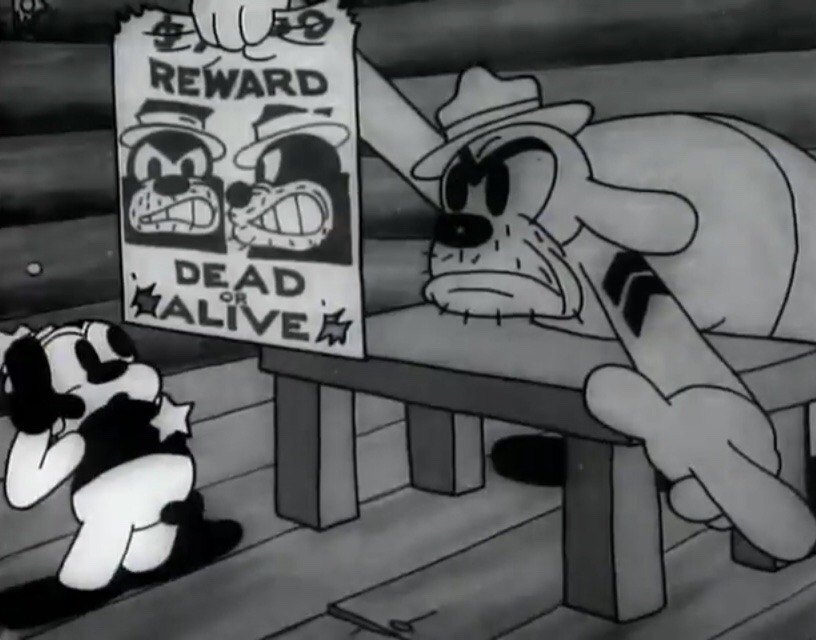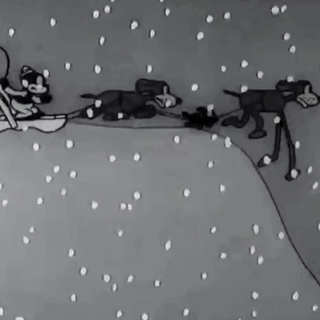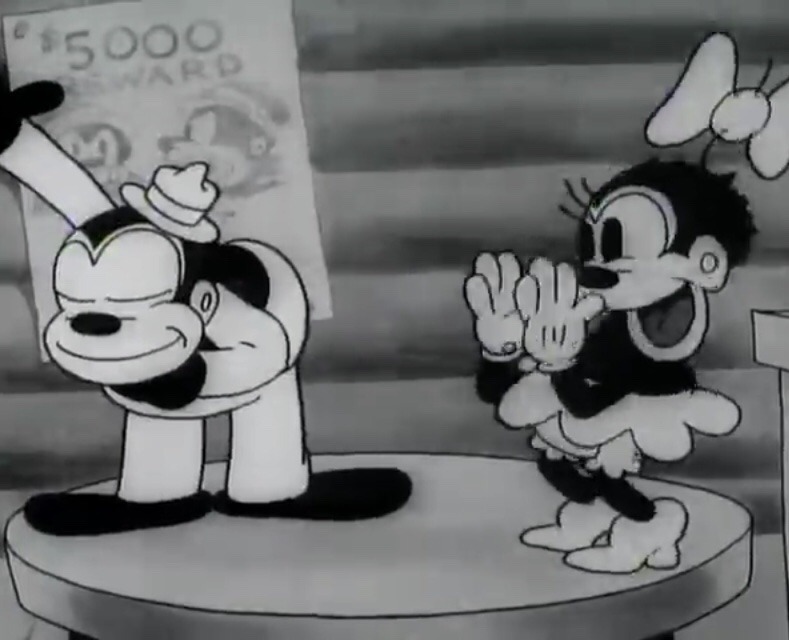Release date: January 9th, 1931
Series: Looney Tunes
Director: Hugh Harman and Rudolf Ising
Starring: Bernard Brown (Bosko, Honey), Rudolf Ising (Sergeant), Ken Darby (Villain), Purv Pullen (Dogs)
The first short of 1931! A lot would happen this year: Merrie Melodies would debut (hence why I put series on these posts, there IS a difference, or was until around 1942), Foxy and Piggy would make their debuts, Rudolf Ising would direct all of the Merrie Melodies shorts, and soon Hugh Harman would direct all of the Looney Tunes shorts... a lot of stuff! But for now we’ll focus on Big Man from the North.
The short opens with a shot of a treacherous snowstorm. The focus is on a little log cabin with the sign “Mounted Police” in front of it. Inside, we’re greeted with a general mechanically pacing back and forth, and the accompanied sound of a crank as he turns makes for a really funny gag.
Suddenly, Bosko bursts in donning a Mountie uniform, and together they try to keep the door shut against the wind. Some great rubbery animation here! I know that’s what the rubber hose cartoons were all about, everything feeling rubbery and loose, but it’s still a lot of fun to see. Bosko holds onto the general who is fighting to keep the door shut, and the wind is so fierce that Bosko ends up flying against the wall, along with the general’s pants. He sheepishly returns them as the general, finally shutting the door, gets down to business.
He orders Bosko to bring him a grizzly looking brute, the eponymous big man from the north. Bosko gulps “Who, me?”, clearly hesitant, but the general barks at him to go, and Bosko heads into the storm, traveling to a saloon via dogsled.
The little dog in the middle is a nice touch, it’s funny and breaks up the predictability. This gag, both the extended legs and a little animal in the middle of a line would be used multiple times in future cartoons (Tex Avery’s Porky's Preview comes to mind where both of these are used 10 years later).
Bosko marches into the saloon, armed, and we’re greeted with this shot. I love it! How nonthreatening can you get? The incongruity between the big guns he’s holding and his diminutive size as well as unaffected expression set this up for a great joke, as well as the heightened importance on him with the up close camera angle.
Bosko spots Honey, who’s standing on a table and singing to a rowdy audience. Bosko is charmed by her and joins her, and is greeted by warm applause. This is one of those cheery scenes that you can’t help but feel happy watching, very uplifting and catchy!
A few gags are reused during this sequence. The matryoshka of birds opening their mouths and diving into each other is reused from Congo Jazz, whereas Bosko, who is now playing the piano, slides his finger down the keys, catapulting then into the air, in similar fashion as Bosko, the Talk-Ink Kid. I like that they reused the animation (or at least recycled the concepts), it feels like a nice callback and fits the happy nature of the scene well.
Unexpectedly, gunshots interrupt Bosko’s piano playing as we are greeted with the big man from the north, slinging pistols left and right. He stuffs his pistols in their holsters and laughs, before hobbling over on his peg leg to the bar. The scene where he hobbles to the bar is pretty funny because of how absurd it is, you have this giant beast laughing menacingly and spraying the saloon with bullets, and instead of a swaggering, proud walk as you’d might suspect, you get him waddling around.
Trembling, Bosko points a gun at the big man and tells him that he’s arrested. He goes to shoot, but, of course, it’s not a real gun, but a pop gun. The big man laughs and starts to pull out a gun that’s bigger than Bosko himself, when Bosko spits at the lantern above them, putting out the flame and thus shrouding the scene in darkness.
We then get this really neat shootout scene in the dark. This is a really clever way to do things! You don’t have to animate the characters shooting at each other, but just make the scene dark instead, which creates a level of suspense as you don’t know who’s shooting at what and what will happen next.
Gradually, the darkness fades and we see the big man unharmed, with Bosko nowhere in sight. Bosko then pops out of a spittoon with a machine gun and shoots the big man senseless. The big man is unscathed, but pissed. He brings out a dagger and chases Bosko with it. He leaps for the saloon doors, but gets his head stuck. Seeing his chance, Bosko (rather gruesomely) shoves the dagger straight in the big man’s ass. It’s actually pretty painful to watch, definitely a violent yet absurd scene. There’s no blood or anything, but shoving a giant dagger deep into someone’s ass isn’t too pleasant.
The big man pulls it out and charges at Bosko, who snatches a rifle from the wall and shoots once more at the big man.
All of the big man’s fur is shot off, leaving him naked and afraid and scrawny. Mortified, the (not so) big man runs out of the saloon, but not before dropping his underwear and hiking them back up. All of the customers applaud Bosko’s bravery as he beams and proudly puffs out his chest. Iris out.
What a promising start for 1931! I really enjoyed this cartoon. It’s the closest thing as to what the rest of Looney Tunes shorts would look like, as in there was an actual PLOT to it. And it worked well! There was a nice little musical interlude in the middle to raise spirits and keep with the theme of musical cartoons. Even though there’s hardly any dialogue, that doesn’t deter it from being any less interesting. I actually think that adds to its charm and effectiveness at storytelling. Overall, a very entertaining cartoon! I have high hopes for what’s next to follow!














No comments:
Post a Comment